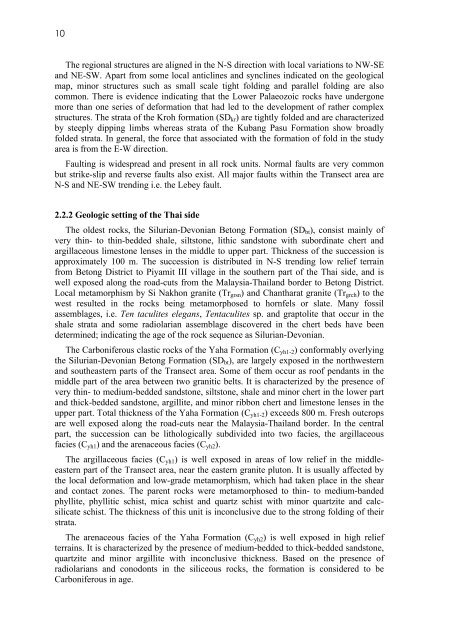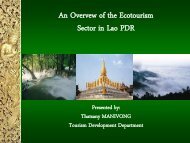GEOLOGY OF THE PENGKALAN HULU-BETONG TRANSECT ...
GEOLOGY OF THE PENGKALAN HULU-BETONG TRANSECT ...
GEOLOGY OF THE PENGKALAN HULU-BETONG TRANSECT ...
You also want an ePaper? Increase the reach of your titles
YUMPU automatically turns print PDFs into web optimized ePapers that Google loves.
10<br />
The regional structures are aligned in the N-S direction with local variations to NW-SE<br />
and NE-SW. Apart from some local anticlines and synclines indicated on the geological<br />
map, minor structures such as small scale tight folding and parallel folding are also<br />
common. There is evidence indicating that the Lower Palaeozoic rocks have undergone<br />
more than one series of deformation that had led to the development of rather complex<br />
structures. The strata of the Kroh formation (SDkr) are tightly folded and are characterized<br />
by steeply dipping limbs whereas strata of the Kubang Pasu Formation show broadly<br />
folded strata. In general, the force that associated with the formation of fold in the study<br />
area is from the E-W direction.<br />
Faulting is widespread and present in all rock units. Normal faults are very common<br />
but strike-slip and reverse faults also exist. All major faults within the Transect area are<br />
N-S and NE-SW trending i.e. the Lebey fault.<br />
2.2.2 Geologic setting of the Thai side<br />
The oldest rocks, the Silurian-Devonian Betong Formation (SDbt), consist mainly of<br />
very thin- to thin-bedded shale, siltstone, lithic sandstone with subordinate chert and<br />
argillaceous limestone lenses in the middle to upper part. Thickness of the succession is<br />
approximately 100 m. The succession is distributed in N-S trending low relief terrain<br />
from Betong District to Piyamit III village in the southern part of the Thai side, and is<br />
well exposed along the road-cuts from the Malaysia-Thailand border to Betong District.<br />
Local metamorphism by Si Nakhon granite (Trgrsn) and Chantharat granite (Trgrch) to the<br />
west resulted in the rocks being metamorphosed to hornfels or slate. Many fossil<br />
assemblages, i.e. Ten taculites elegans, Tentaculites sp. and graptolite that occur in the<br />
shale strata and some radiolarian assemblage discovered in the chert beds have been<br />
determined; indicating the age of the rock sequence as Silurian-Devonian.<br />
The Carboniferous clastic rocks of the Yaha Formation (Cyh1-2) conformably overlying<br />
the Silurian-Devonian Betong Formation (SDbt), are largely exposed in the northwestern<br />
and southeastern parts of the Transect area. Some of them occur as roof pendants in the<br />
middle part of the area between two granitic belts. It is characterized by the presence of<br />
very thin- to medium-bedded sandstone, siltstone, shale and minor chert in the lower part<br />
and thick-bedded sandstone, argillite, and minor ribbon chert and limestone lenses in the<br />
upper part. Total thickness of the Yaha Formation (Cyh1-2) exceeds 800 m. Fresh outcrops<br />
are well exposed along the road-cuts near the Malaysia-Thailand border. In the central<br />
part, the succession can be lithologically subdivided into two facies, the argillaceous<br />
facies (Cyh1) and the arenaceous facies (Cyh2).<br />
The argillaceous facies (Cyh1) is well exposed in areas of low relief in the middle-<br />
eastern part of the Transect area, near the eastern granite pluton. It is usually affected by<br />
the local deformation and low-grade metamorphism, which had taken place in the shear<br />
and contact zones. The parent rocks were metamorphosed to thin- to medium-banded<br />
phyllite, phyllitic schist, mica schist and quartz schist with minor quartzite and calcsilicate<br />
schist. The thickness of this unit is inconclusive due to the strong folding of their<br />
strata.<br />
The arenaceous facies of the Yaha Formation (Cyh2) is well exposed in high relief<br />
terrains. It is characterized by the presence of medium-bedded to thick-bedded sandstone,<br />
quartzite and minor argillite with inconclusive thickness. Based on the presence of<br />
radiolarians and conodonts in the siliceous rocks, the formation is considered to be<br />
Carboniferous in age.



